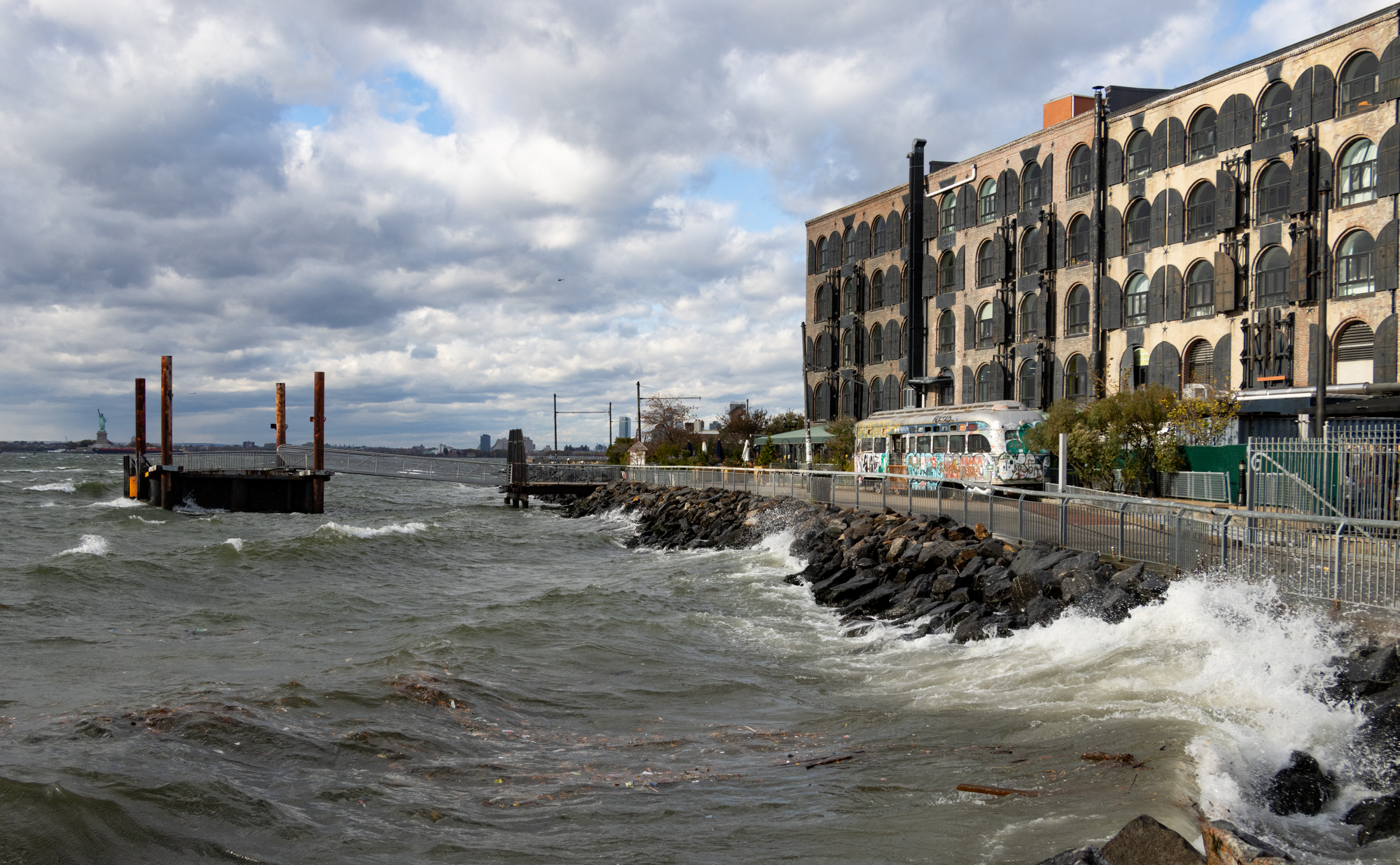Restoring Downtown Brooklyn to Its Former Grandeur
If you didn’t realize downtown Brooklyn was once grand, talk to Bob Furman, founding member of the new group Brooklyn Preservation Council. The Brooklyn Eagle reported on Furman’s hopes for the area. They include raising awareness about the urban fabric that existed there before the Robert Moses-championed Cadman Plaza and Columbus Park replaced some 300…


If you didn’t realize downtown Brooklyn was once grand, talk to Bob Furman, founding member of the new group Brooklyn Preservation Council. The Brooklyn Eagle reported on Furman’s hopes for the area. They include raising awareness about the urban fabric that existed there before the Robert Moses-championed Cadman Plaza and Columbus Park replaced some 300 buildings, including a few neo-classical treasures, in a fit of urban renewal in the post-war years. “While we can’t rebuild the way it used to be, I thought it would be appropriate to commemorate what it once was, he says. I always felt that the Downtown Brooklyn and Cadman Plaza renewals were disasters. [Their] purpose was to reverse the decline of Downtown Brooklyn and Brooklyn Heights, which [they] didn’t do. One building especially missed is the neo-classical Kings County Courthouse, razed and eventually replaced by Brooklyn Law School at Joralemon Street and Boerum Place, made with Tuckahoe marble and designed by Borough Hall’s architect, Gamaliel King. Hopefully the signs Furman hopes to erect, commemorating lost streets and buildings, will help deter us from making the same mistakes today.
Preservationist Looks to Commemorate Downtown Brooklyn of Old [Brooklyn Eagle]
Cadman Plaza. Photo by r5n5.





I see benson came through again. Way to go dude- you really got to get that paranoia/ I am the god of all knowledge thing under control. Maybe you and What can share a shrink or something. Go. mingle. Shrink amongst yourselves.
benson- well, my mistake. Here I actually thought it was a remote possibility that someone could hold a real dialogue with you where your conceit and smug arrogance could actually be set side for a few lines of civil type. I know it never occurs to you that yours is not the whole story. No, heaven forbid the self-appointed keeper of the industrial flame would never ever think that.
Re Venice- is it possible you simply don’t read anything anyone else posts? Was I the only one to disagree with you about Venice? No. was I the first to do so? No. So bug off on that.
For a guy who indulges in broad, paranoid, save-our-industry rants and thinks preservationists are single-handedly stopping all public works in this city, I have to admire your complete lack of self-awareness. You’ve laid into me time and again just like you’ve laid into Lisa, and you really should get help for that conspiracy theory thing you’ve got going on.
As for Robert Moses- your overly simplified information is written completely to support your point of view and is woefully inadequate as an explanation or a rebuttal. So if you don’t agree with what I write, skip my posts. That’s all it takes.
Bxgrl (and East River);
Bxgrl: one of the reasons I don’t like to debate with you, as opposed to worthwhile opponents like East River and Montrose, is that you argue for argument’s sake, and make dramatic statements that are completely lacking in context. You treat my statement that “Venice is a dying city” as if it were some wild new thought out of left field. Yet this problem is widely acknowledged by all, including Venetians themselves. Google the phrase “Venice is a dying city”, and see how many hits you get. Here’s just one:
http://durham21.co.uk/archive.asp?ID=3541
More important than any statement I can make about this topic is this fact: Venetians are voting with their feet, and leaving. The population of Venice has declined by about SEVENTY FIVE percent over the past 30 years, and, as the article I cited shows, it is projected that Venice will be completely depopulated in 30 years. You call this the city far more alive than New York? Please spare me the breathless prose that you write just to argue.
Now, moving onto the substantive points. You (and East River) are incorrect about Robert Moses. He never controlled the purse strings concerning mass transit. This is an objective fact that not even Robert Caro disputes. I challenge you to show evidence that he controlled the funding of mass transit, and in that capacity moved funds away from it and towards highways. The Triborough bridge authority NEVER controlled the funding for the mass transit system when Moses ran it. Rather, it was only when the MTA came into being that there was a single agency to oversee funding of all forms of transit, and it was precisely when the MTA was created that Moses was pushed out. We can all see how well the MTA has done since that time. Moreover, I believe you exaggerate his influence. Look though the historical record and see if he was behind the legislation that created the highway program (like the Interstate highway system) and the Title 1 housing programs. What Moses was, and how he thought of himslef, was a very effective implementer.
“THIS is the era in which Moses operated, and he worked within these constraints to get things done.”
benson-Just wanted to add something to bxgrl’s comments on Moses because your statement is really inaccurate and despite what you think, she seems to know quite a bit about the era.
Moses wasn’t just immensely influential in NYC and NYS. His ideas influenced urban planning in cities all over the country. The man had major clout. He had power, and access to major money, so in his heyday, he pretty much could do whatever he wanted. And He had virtually free rein. He controlled the direction of public transportation and road development. He ran agencies that operated without public scrutiny. It’s far more likely the Cincinnati City fathers abandoned their subway because Robert Moses believed in the car culture. By emphasizing this, he set in motion the future of bumper to bumper traffic, dependence on oil and pollution.
I’ll posit another idea for you. Years ago the trains wee the major means of moving goods across the country. trucks were localized. the system must have worked- just look around you and you’ll see exactly how successful the movement of goods in and out of the City was. Look at the skyscrapers that went up, the homes that were built, the parks and hotels. The trains and trolley systems. All before Robert Moses and his roads.
The population in the 20’s-30’s was well over 7,000,000. Not all that much smaller than today- my point being the roads he built were conducive to making us car-dependent, not more efficient. He had a grand vision of linking the cities, grand spaces, public parks and massive housing projects to warehouse the poor. Mass transit just didn’t fit into that vision and that’s the real reason he basically ignored it.
Venice is far from dead. There are certain physical reasons as to why Venice is concentrating on preservation, not development, and in fact, new development may not be all that feasible. But a dead city? Not hardly. It’s people who make a city come alive, not the developers. Venetians appreciate and respect what they have and they’ve weighed the costs. Even as “just a museum” Venice is much richer, more inspiring and far more alive than the NYC we are becoming.
Whatever you may say about Robert Moses, he was an advocate of the car and was often accused of ignoring public transport in favor of cars. With almost total control over public spending for urban planning and as head of the Triborough Bridge authority ( he held a number of positions in public authorities all at the same time) he was able to put funds where he wanted- and that included into mass transit. But he was a believer in “car culture.” This is the man who wanted to put a superhighway- how dumb is that?- through Manhattan which would have destroyed both Greenwich Village and Soho. He saw highways not just as conduits, but monuments. He built infrastructure for cars, not mass transport for people and the end result is traffic congestion, and inadequate mass transportation.
As he gained more power he created huge public housing projects without regard to quality of living or scale. Sometimes he bulldozed as many apartments as he would rebuild on site. They are outstanding failures. He increased roads and access for people with cars (wealthy, white at that time) while vetoing improvements in mass transit so that urban Blacks could not get to Jones Beach or the State Parks he created. Even overpasses were purposely set too low for buses. Sure you could say he was a product of his times but the end result is still the same. He could have improved mass transit and chose not to.
Montrose;
Good post, as usual. I think we can agree that some balance is necessary. However, when we have a situation whereby the city has not undertaken one major public improvement in 50 years (except for the warter tunnel), I would say that we do NOT have a balance.
Here’s a thought experiment for you. Take any of the large public works undertaken in NY, and try to imagine if they could be done today. Imagine the city trying to widen Houston St in Manhattan today, as it did when the “F” line was built. Imagine the city building another Flatbush Ave extension, which connected the Manhattan bridge to Flatbush Ave at the Atlantic Terminal area. Mr. Walsh and his cohorts at Forgotten NY would go ape, running story after story with photos of “What We’re Losing”. You know, I used to like Forgotten NY when he used to focus on historical trivia and such. But read his more recent stories, and they become increasinly strident in the rants about development.
Carol Gardens: the point I was trying to make was that Venice used to be one of the most dynamic cities on earth, artistically, commercially and miltarily. During this time, it continued to evolve, allowing development in Saint Mark’s over a period of 500 years. If you look at the buildings in this square, you will see that they are from a range of eras. Now the city just focuses on preservation, and it is no longer a living city. It is just a museum. A magnificent one at that, but nevertheless, a museum.
Interesting that in order to preserve Venice, Italy is undertaking the most extensive public works project in its history.
(And by the way, I was kidding. It’s just amusing to me that there was praise for the square, and on the heels of that comment, a put-down about Venice as “no longer a living city.” Sounds negative to me!)
http://www.npr.org/templates/story/story.php?storyId=17855145
“MOSE, the acronym in Italian for experimental electromechanic module, is the biggest public works project in Italian history.
MOSE is also the Italian word for Moses, recalling the biblical parting of the Red Sea.
The project is building 78 floodgates at the three inlets that link the Venice lagoon to the Adriatic Sea.”
Benson, sometimes I think we understand each other, whether we agree or not, and other times it’s like one of us is speaking English with a really thick patois. I am not defending or dissing the creation of Cadman Plaza, per se. First of all, what’s done is done, and all my wishful thinking will not bring back what was there before. I don’t even think that is the intention of the gentleman who started the Brooklyn Preservation Council. He clearly states that he wants to educate people and celebrate what was there before the creation of the Plaza, because it was worthy of rememberence. There is nothing wrong or sinister about that. As I said before, we can learn from the past, and use the best of it to create a successful future.
We can debate on the success of the Plaza all day. I happen to think that the part near the Supreme Court and Borough Hall is great. I’ve eaten lunch sitting on the benches that line the plaza, I’ve shopped the farmer’s and flea markets there, and admired the flowers. I think as you move further down, the space is less successful, and the monument does not get the attention it deserves, and much of the space is wasted. But this is all I’ve known, obviously, as the old courthouse and other buildings were gone well before my time. If there was a will, much could be done to make all of the space more productive and beautiful.
I do not find it a waste of time, or a testament to one’s fear of progress, to celebrate the past. I enjoy Forgotten New York, and see his work, and others like it, as filling in the gaps of history. Some gaps are important, others just interesting trivia, but all help us to understand all of the complex things that have gone into making this city. I don’t think anyone honestly expects the clock to stop on building, or in making progress in NYC. Rather, that we take the time to see what we are doing before leaping into doing it. True historic preservation is not creating a time bubble around cities. When done right, with thought towards both the past and the future, preservation should allow a window to the past to remain open, while encouraging good, sensible, sustainable work to flourish for tomorrow. Sometimes that means preserving an Admiral’s Row, through adaptive reuse, other times, it may mean recreating an historic room in another location before the building is torn down, and sometimes it means saving that building in situ. We need to be flexible, and adaptive. Neither one of us is wrong, here. Both preservation and progress is needed
First of all, Venice is not a theme park it is an icredibly well preserved art city like Florence, Toledo, Bruges, etc.
These places are irreplacable components of our shared cultural patrimony.
Secondly, there is nothing wrong with theme parks. get over yourself, you’re not the reincarnation of Herbert Muschamp.
Thirdly, there are many parts of brooklyn that have been eroded aesthetically over the past hundred years but Cadman Plaza is not one of them. Old photos show a mish mash of elevated train tracks, trusses, debris, signage, in short, Victorian blight. The area looks much better today than it did then. AT least as a pedestrina you can see the sky and do not have to worry about falling soot from the train tracks. I would counsel Mr. Furman to pick an area that actually looks worse today than a hundred years ago.